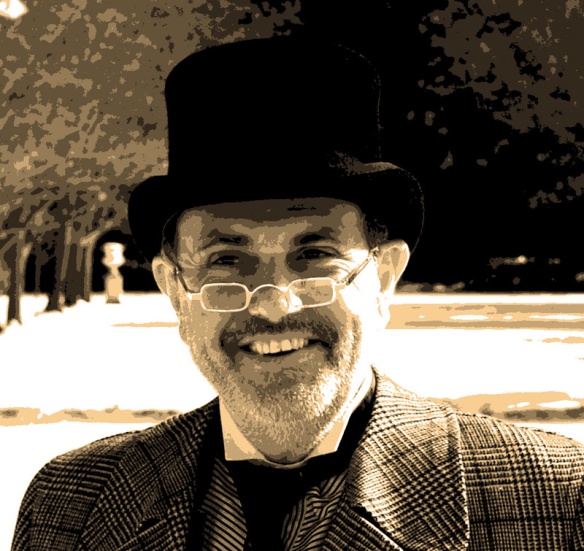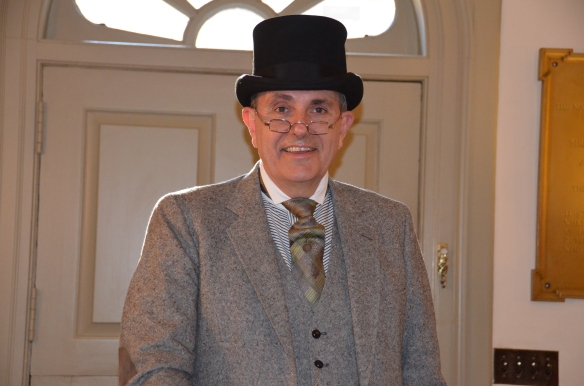I eagerly anticipate appearing as the Kevin Nicolay lecturer at the Northwest Perennial Alliance’s meeting on Sunday March 16, 2014. If you are in the area, I encourage you to join me as I investigate what the Olmsted Brothers (my sons!) did to design this country’s third largest municipal parks system. The time is 1:00 PM at The Center for Urban Horticulture on East 41st Street.
Author Archives: Kirk R Brown
Chambersburg Master Gardeners and Olmsted’s Civil War Experience
“What is human warfare but just this; an effort to make the laws of God and nature take sides with one party.” –Henry David Thoreau
“Mankind must put an end to war before war puts an end to mankind.” –John F. Kennedy
It’s been nearly a century since the great fire of Chambersburg was ignited as one of the penultimate acts of defiance by rebels under orders from Brig. Gen John McCausland.
As the only major community burned down by Confederate forces during the Civil War, the borough had failed to provide a ransom of $500,000 in US currency or $100,000 in gold when the town was invaded for the third time on July 30, 1864. It was from Chambersburg that John Brown staged weapons and ammunition in the run-up to his ill-fated attack on Harper’s Ferry in 1859.

The kitchen of Mary Ritner’s boarding house has a table that once sat John Bartram and his partisan assembly of abolitionists.
Mary Ritner kept a boarding house at 225 East King Street. John Brown and several of his co-conspirators rented rooms from her while planning the take-over of the federal depot. The town was a center for abolitionist sentiments and served as a way station to the Underground Railroad because of its service as a railroad junction.
In the intervening ninety-nine plus years, gardeners have been extremely busy beautifying the city. This year, dozens of them came together under the banner of the State Master Gardener’s Association to celebrate at their annual banquet.
Let me state unequivocally: Frederick Law Olmsted is an abolitionist. I wrote extensively of my travels through the slave states of Alabama, Louisiana and Texas in “A Journey in the Seaboard Slave States; With Remarks on Their Economy.” Nothing about the system is sustainable.

Entertaining the guests is always part of the thrill of speaking about Landscape Architecture and the history of its art and practice.
Landscape design and execution, on the other hand can be very sustainable. The art and theory of Landscape Design should be extended as a perfect way to solve the problems facing human kind by urban crowding, general health of the population, and natural preservation. Without it we are simply abusers of the wealth given by God that we have been charged with stewarding.
Centennial Celebration: Olmsted Dedication in Central Park
“It has always been, and still is, my intention to build a playground in Central Park.” –Diana Ross
“My parents weren’t around much, but I assumed everybody’s family was the same. I didn’t know people had mummies and daddies who would give them milk and cookies after school. I just thought everybody lived on Central Park West and they had a nanny to take care of them.” –Stephen Sondheim

Representatives from all of the 50 states gathered to dedicate the new two acres of park restoration.
The Garden Club of America celebrated its 100th anniversary by restoring a two-acre section of Central Park. The site selection, official approvals, initial groundbreaking and final dedication ceremonies were all completed in collaboration with the Central Parks Conservancy.

Receiving the award certificate on behalf of CPC was Christopher Nolan, Vice President of Planning, Design and Construction. Here Nolan is seen with Frederick Law Olmsted.
GCA committed its 2013 Founders Fund for this special Centennial Project.

Frederick Law Olmsted in a moment of reflection next to the stone wall of his design surrounding Central Park.
As this portion of the park was originally envisioned by Frederick Law Olmsted and Calvert Vaux, the woodland’s edge design brought a nature’s experience to inner city residents.
Mayor of New York City, Michael Bloomberg proclaimed June 3, 2013 as ‘The Garden Club of America Day’ in New York City to coincide with the formal dedication ceremony.

Marian Hill, President of GCA, and New York’s Park Commissioner, Veronica White, present the Proclamation.
The restored landscape planting is at the East 69th Street entrance to Central Park and is only blocks away from the Metropolitan Museum of Art.

CPC/GCA Liaison Natasha Hopkinson, CPC VP Christopher Nolan, CPC Founder Betsy Barlow Rogers, NYC Parks Commissioner White & GCA President Marian Hill at dedication.
Representatives from all 50 states’ Garden Clubs were present as the director of the Central Parks Conservancy, President of the Garden Clubs of America, and notable committee members spoke to the historic principles of natural preservation recognized by this partnership.
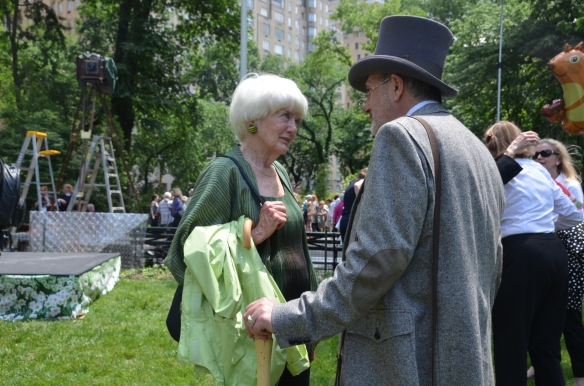
Betsy Barlow Rogers, founder of Central Parks Conservancy discusses the restoration with Frederick Law Olmsted. Rogers observed that GCA members volunteered to restore this section of the park.
Frederick Law Olmsted was present at the ceremonies as delivered by his amanuensis, Kirk R. Brown. The day was spectacular in the warmth of a summer sun and singularity of the gardeners’ passionate dedication to their art.
Ten Real Reasons Why Lay Liturgists Volunteer!
I lived through the second great reawakening. I thought I could preach. At some time. Then nature called and I went in other directions.
God has always been a great part of my nature. I feel his presence in the woods, the wards, and the words. I see his activity in the world. When I stand up in front of an audience, there is the air of sanctity about it. Worship in any world should be a passionate experience.
I tire of those who would recite the reasons why we can’t, or shouldn’t, or won’t, or don’t. I look forward to the positive experience. I encouraged my amanuensis to express our feelings. And so he did.
Kirk R. Brown wrote from the depths of his experience. And believes that the best part of life is yet to be felt:
- A Lay Liturgist, appearing before the congregation, can convey a sense of passionate and connected worship totally unlike a member of the paid staff. It demonstrates a level of volunteerism that should encourage more of the same from others in the audience.
- A Lay Liturgist draws on sources of inspiration from a working world. Having business people, retirees, teachers, job-seekers, house tenders, child-rearers, and musicians serve in this capacity should illustrate how those careers can illuminate a spiritual existence.

- Lay Liturgists should extend a welcoming hand to new congregants. This church is ours. We live here, work here, and worship here. That’s a radical concept!
- In the course of week of preparation, a Lay Liturgist reaches into the source of his/her faith and confirms why it is and what it is. This is a truly great reward of service. This nourishes the individual’s faith and confirms a sense of communion with the body.
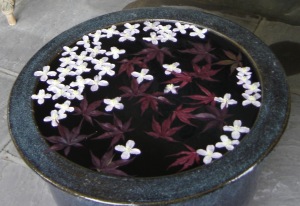
- In preparing for the moment in every service when the Lay Liturgist offers a communal prayer, it is a step in intentional faith development. In every word and at every turn of phrase, the community of faith is joined within the enlarged concept of “The Lord’s Prayer.” Two thousand years of Christian faith is merged into the present company of believers.
- Every service led by a Lay Liturgist is an extreme example of risk-taking mission and service. It is a challenging podium over which to accept responsibility. The opportunity to appear before a congregation is awesome and terrible. Those who remain comfortable in the pews cannot possibly conceive of the sense of wonder and dread that fills the heart of the committed Lay Liturgist.
- In every prayer that lifts up a congregation’s joys and concerns, the words coming from a member of that congregation can carry a greater depth of involvement and personal reflection. Knowing the congregation as a member of laity does, over so many more years, adds a depth of reason and an acknowledgement of passing years that is otherwise lost in transitions.
- A Lay Liturgist can interact with a congregation on its own personal level. There is no intervening ecclesiastical wall or artificial distancing. It’s an opportunity for spontaneity, humor, sadness, veracity, communality—life! in short—that freshens and enlivens the service format.

- It is an aspect of this service that it confirms an active intent to be a disciple of Jesus Christ. If the world can be transformed in the process, then so much the better.
- Simply put, a Lay Liturgist has a real reason to volunteer because it is a pleasure and a joy. Through this act, a spiritual thirst is quenched.
A Capitol Memorial Day
“I remember when I first came to Washington. For the first six months you wonder how the hell you ever got here. For the next six months you wonder how the hell the rest of them ever got here.” Harry S. Truman
“I often say of George Washington that he was one of the few in the whole history of the world who was not carried away by power.” Robert Frost
I returned to Washington DC over the Memorial Day weekend. It was an opportunity to experience the many changes time and terror have made to the original concept of making the West Front of the Capitol Building a grand lawn for the nation to celebrate major patriotic events.
Since my last visit, a non-profit organization was chartered in 1962 by Congress to, “to educate the public on the history and heritage of the U.S. Capitol building, its institutions and the people who have served therein.” For the specifics of the need to establish a non-federal, privately funded organization to tell the general public about our nation’s legislative house visit another website: http://www.uschs.org/about-us/about-the-society/
The name of the organization is The United States Capitol Historical Society. Their Chief Guide and Public Programs Manager is Steve Livengood. He led us on a merry route around the perimeter of the grounds.
Beginning on the terrace of the terrace of the US Botanic Garden, the tour headed east towards the closest access to the lowest level of terracing on the mall side of the building. A sprawling stage had been set up fronting a massive sail of canvas and bunting. The majestic lawn of the West Front was surrounded by a bulwark of orange tapes, traffic barricades and official police presence. The group accompanying me posed for a photo on the landing dedicated to the fallen heroes of the Civil War.
It’s known as the Grant Memorial. I knew U.S. Grant. After his presidency. During the scandals that came afterward. I was with him in New York as he was writing the memoirs that would support his family after the cancer completed its course. He was a great man. The Memorial is monumental but it is still not as grand as the man. His life was perfect for his time and his place. He delivered the Republic back to the hands of the people.
It was an auspicious location. It was also the closest we came to viewing the work for which Olmsted and the partnership is famed. On our groups approach, guards came forward to prevent us accessing the lawn and terraces.
Steve decided to walk and talk our way along the south façade and past the Rayburn congressional office building on Independence Avenue. We heard about the plan to open up the true “front” of the building as originally envisioned by Pierre Charles L’Enfant. He was French but wanted to be known as Peter when he was working on the original plan of the city.

The tour stops on the steps to the Rayburn Office Building across from the South terrace of the Capitol building.
Imagine the designer putting plans on paper for a city of 500,000 people when the site was mostly a tidal swamp prone to culturing more mosquitos than people. His vision was grander than Paris or London in its time. He had a blank slate on which to write historic large letters dedicated to the majesty of America’s great political Republic. Not since Roman times had such power been wielded by the general public.
As with most singularly unique concepts, the design languished in the control of three commissioners. L’Enfant was replaced after the site had been surveyed and pinned. The streets were run but it would be years until anyone could see visual supremacy of his populated capitol.
The building housing our bicameral house of legislation grew by needs and starts. Senate and House added wings. The dome was finally completed. But the main entrance for its first 100 years of existence was the East Front.
The mall was cut out of a city built up of blighted tenements and squatter’s shacks. The museums came later to save the avenue that now connects the Capitol with the Washington Monument. The tree-lined avenues edged with marble-faced buildings that a casual visitor now experiences around the Capitol were unknown to President Lincoln.
Somehow L’Enfant’s vision, although 200 years in the creation, was fulfilled with the energy and strength of children four or more generations removed from the fountainhead.
Our tour group reached the top of Capitol Hill. We walked around the cordon of security barriers. Access to the building was blocked. We could hear music played by the National Symphony. We stood silent as a big-voiced soprano added conspicuously extraneous notes to the singing of the Star Spangled Banner. I hummed along. I stood proud as I viewed all that had been created. I was reconnected to being an American.
We crossed the street and climbed the stairs to the old Library of Congress. Sirens screamed. Lights flashed. Large black Mariahs pulled up to the curb in front of us. Armies of black-capped security personal, bristling with armour and badges and weapons raced up the steps. We were under siege. They shouted and signaled: “Off the steps! Now! Move, move, move!!!”
We just ran. “Bomb scare! In the Library of Congress…move away fast.”
The times have changed. Events are larger than architecture. No one notices a man in a top hat with memories of how it used to be when the nation could have an uninterrupted party on its front lawn.
Happy Memorial Day. I remember other events held on the same anniversary. But I continue to feel just as proud to be able to say, “I am an American.” I thank Steve Livengood for reminding me how important and unique that is.
Nemours Mansion and Garden on the longest day.
“Can’t repeat the past?…Why of course you can!” F. Scott Fitzgerald. The Great Gatsby.
“Do you ever wait for the longest day of the year and then miss it? I always wait for the longest day of the year and then miss it!” F. Scott Fitzgerald. The Great Gatsby.
It was a trip that took only a few hours. Arriving as we did on a morning of exquisite sun and warmth, we looked forward to a day that included garden tours, architectural design, and reasonable expectations for working ideas.
As the day opened, we knew that it was the summer solstice: the longest day of the year. And we had the added pleasure of experiencing it in magnificent surroundings. How many hours does it take to turn clocks back to the years before our memory?
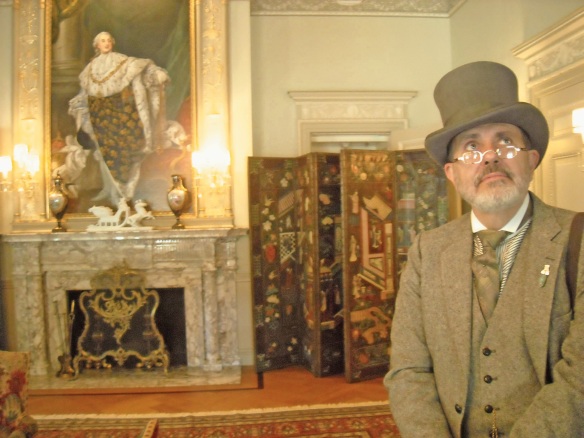
The tour included the dining room. The table was formally set and inspected by the royal gaze of a Louis in a gilt frame.
The tour started with a walk down a corridor filled with dates and photos of major events. It was a walk through the history of newsmakers that ran parallel to the lives of those we would get to know. The trail down history’s lane led us to a theatre. A movie told biographical details of a privileged life beset with major emotional obstacles.
Nemours Mansion and Gardens is an estate that recreates a gilded age of 18th Century French landscape design with a not a little help from Louis XVI’s architectural apotheosis at Versailles. It was built during our own gilded age of industrialism, technology and unlimited dreams. It was finished at the height of our Great Depression.
The house is a model built for a second wife who loved everything French. She obviously had the wallet of A. I. Dupont available to satisfy every small detail. The lavish interiors are crammed with French art on the walls, stuffed in the curio cabinets, and carpeting the floors. Incredible examples of authentic, period-correct French furniture glow with gilded patina and petit-point needlepoint.
The dining room table expanded under the gilt-framed gaze of a royal Louis. It was set with porcelain nymphs frolicking around fresh flowers, candles, crystal, silver, and Meissen. The chandelier over our heads was said to come from the Schonbrunn Palace in Vienna. Marie Antoinette would have recognized it from her childhood in that city. Also, the Schonbrunn had a “French” landscape designed by a disciple of Andre Le Notre–Versailles garden designer.
Outside the front door, a gravel terrace separates the formal architectural block with a series of descending lawn terraces.
The lawns are pristine. No sheep shearing. The shearing is left for the borders on either side. Cryptomeria japonica ‘Yoshino’ create exclamation points of interest. The low-trimmed shrubs connecting the points are Stephanandra incisa ‘Crispa.’ It’s an elegant shading of color down the allee, even if it requires incredible attention to cutting and shaping.
The statues that surround the pool are marble in the French monumental tradition. The larger-than-life-sized “Achievement’ is gilded with 24 carat leaf. It is centerpiece to the formal parterre of colored annuals and trimmed Buxus hedges.
On the other side of the colonnade, another gravel landing separates the architecture from a massive retaining wall balanced between two sweeping marble staircases. these flanking steps are very reminiscent of the grande staircase of the Opera National de Paris. This is a setting theatrical enough for a garden production of “Phantom of the Opera.”
The entire transit of house, garden, terraces, and history left me in a very contemplative mood. I didn’t walk as far as the Temple of Love with its great French bronze statue of Diana, the Huntress. At the end of this longest day I was haunted: with the vision that crafted this elegant life.
Great cubic yards of soil were moved to create this wonder. As with Central Park, the moving of earth is necessary when landscape art is created. Instead of brushes and canvas, the artistic effect is made with swaths of brilliant plants and sparkling marble. The glitter of romance is enhanced with tinkling cascades and shimmering pools of water. The trees that surround the major axis of landscape work wrap up the site with bordering green and fool the eye into thinking that it can’t escape from the magic of the natural artifice.
This dream-like visit on this longest day came to an end before many of us achieved the final vista. We traveled on to the next garden and a brilliant visit a DuPont brother collector of Americana. I recall a quote from a former neighbor of mine. She wrote of a time in our lives when we were remembering war and yet lived to experience a better world. Longest day? Longest night?
“The longest day must have its close–the gloomiest night will wear on to a morning. An eternal, inexorable lapse of moments is ever hurrying the day of the evil to an eternal night, and the night of the just to an eternal day.” Harriet Beecher Stowe.
Frederick Law Olmsted Lives!
“It is good, big work I have in hand!” Frederick Law Olmsted at the start of his work with United States Sanitary Commission, the forerunner of the American Red Cross. He was its field superintendent during the peninsular campaign for the Army of the Potomac during the Civil War.

Taking long walks, rambling, has been a life-long activity for me. There has never been a forest, stream, mountain, or field that has not called to me to investigate, measure and redesign.
“I was active, imaginative, impulsive, enterprising, trustful and heedless. This made me troublesome and mischievous.” —Frederick Law Olmsted
“From this gentleman’s practical training as an agriculturist, His horticultural writings, His talents and character we believe him eminently qualified for the duties of the office of Superintendent of The Central Park New York.” —Washington Irving, and the members of search committee.
“I’m 36 and starting a new career.” Frederick Law Olmsted at the start of his employment on the Central Park Project.

Olmsted never tires of his countryside rambles. All of them are differing views to his unique perception of nature.
“It is one great purpose of the park to supply to the hundreds of thousands of tired workers a specimen of God’s handiwork that shall be to them what a month or two in the White Mountains is to those in easier circumstances.” Frederick Law Olmsted
“Let us not seek for present delight, nor for present use alone. Let us seek such work as our descendants will thank us for.” —Frederick Law Olmsted

